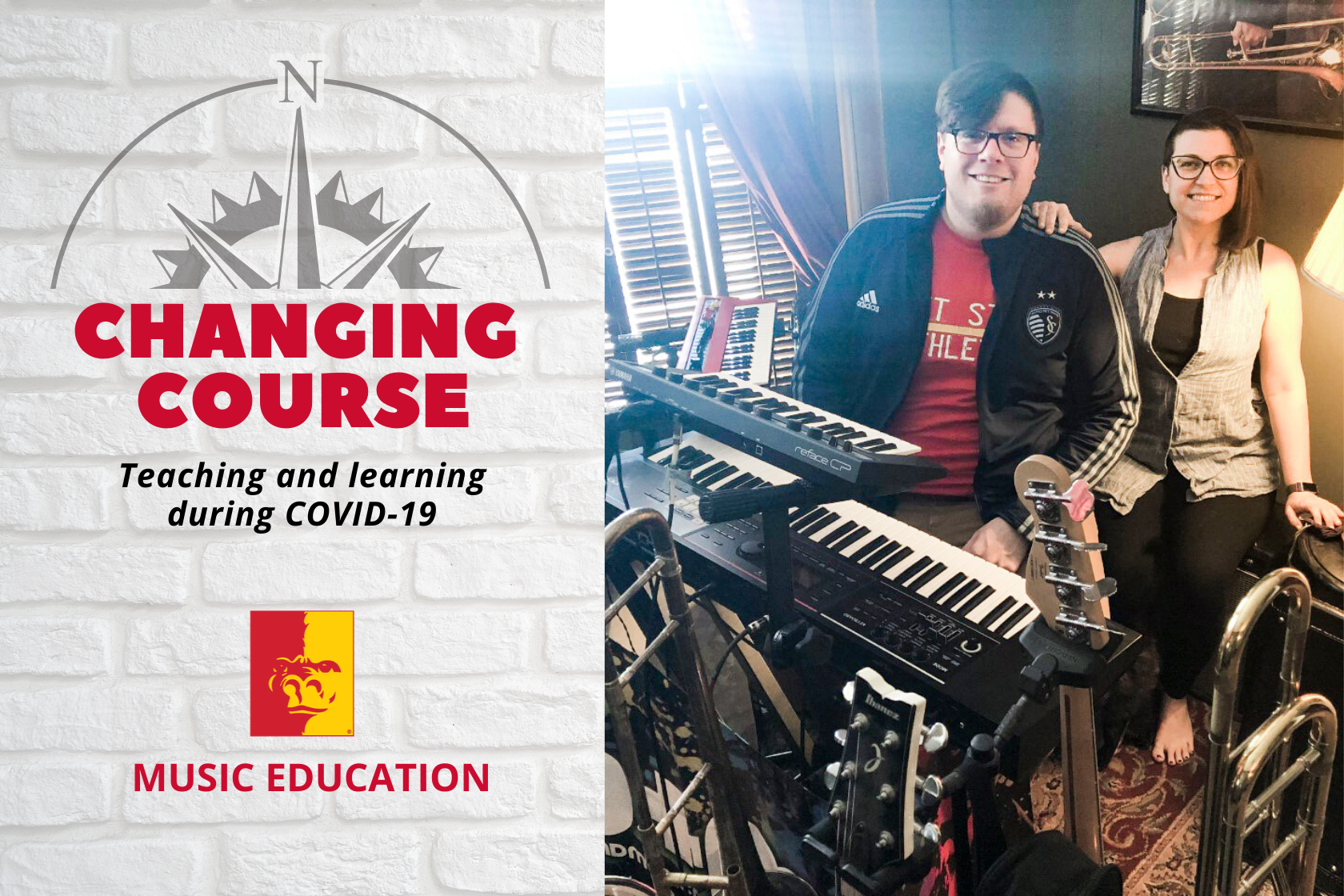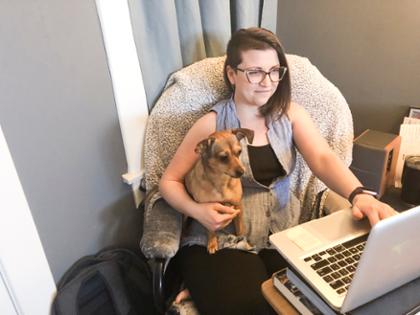Changing Course: Goddards teach music classes from loft apartment
Wednesday, April 15, 2020 4:00 PM
News, Alumni, Academics
Pittsburg, KS

Just as the spring edition of the PittState Magazine arrived in mailboxes across the nation, touting as the cover story the theme “By Doing, Learn,” for which the university is known, the COVID-19 pandemic brought all in-person classes to a halt.
Those who teach and those who learn had to be flexible, innovative, and change course quickly.
In this series, we’re sharing what education looks like from the perspective of our faculty, students, and alumni during a time of social distancing, stay-at-home orders, and remote coursework.
After graduating last May with a degree in music education, a dream came true for Chris Goddard: he got his own music classroom in St. Paul, Kansas — a tiny district in which he could watch his students progress musically from pre-Kindergarten through 12th grade.
A musician himself, he jumped in with both feet in August to make learning innovative and fun. He created an instrument to accommodate a student with strength and coordination deficiencies. He sought a donation of big orange buckets from Home Depot to take students out of the music books and into the world of performance. He crowd-funded a classroom set of ukuleles.
And, he borrowed on the strengths of his wife, Amanda, a 2013 music education graduate who has taught K-8 music and grades 5-8 band at Labette County School District for several years and has put proven curriculum and strategies in place.
In March, both of their classrooms closed, and they transitioned to teaching music — perhaps one of the loudest subjects? — virtually from their small loft apartment in downtown Pittsburg.
Step 1:
They looked at their schedules of Google Meets — Amanda has 15 with her classes — and aligned them.
“I wake up do my first class, then he does one, then I do one, and so on,” she said.
Step 2:
They converted their dining room into a music room.
“I have my microphone set up so we can do voiceovers,” said Chris, a tech-savvy performer and equipment guru with Zero2Panic and Bill and Monica’s Excellent Adventure.
One corner is for livestreaming. One is for practice. Another is for keyboards.
“I’m starting to teach basic beginning theory lessons; we'd be doing that in class right now. I put the camera over my shoulder, show them finger placement on the keyboard, and turn around and talk like they’re there,” Chris said.

Step 3:
The couple began collaborating each afternoon to plan and create videos to share with their students via YouTube. Occasionally, their dog Clara, a shih tzu/rat terrier/chihuahua, makes an appearance, which their students love. An added bonus: they each can play just about every instrument out there.
Luckily, they also like each other’s company; they’ve been together 12 years and marked their fourth wedding anniversary this month.
“He was my section leader in band when I started at Pitt,” Amanda said. “We played together in every band at Pitt State — jazz band, marching band, wind ensemble, orchestra.”
Challenges
“My school owns the majority of my kids’ instruments, and a tough decision was made early on to not send instruments home with them,” Chris said. “I knew I was limited in what I could do with my students compared to what we’d typically been doing.”
So, Chris transitioned his thinking as a teacher.
“My administration has really supported my goal of this being a brain break for them during the day,” he said. “This is such a stressful time — it is for teachers, for parents, and I can’t imagine for the kids. This is a break in their day, they don’t have to worry about doing it for a grade or things being due, they just have to participate.”
He borrowed Amanda’s idea for one of his first lessons: a March Madness-style bracket in which he asked students to listen to songs from a 100-hit list, they compare two songs and vote which is best.
Learning focused
Amanda, with five years under her belt and with older students who were allowed to take instruments home, is making her approach less focused on grades and more on learning.
“One of the biggest problems of education is kids think they’re working for a grade,” she said. “This is a time to get away from that. Our curriculum includes games, activities, warm-ups, stretching.”
They’re both utilizing online resources from the Southeast Kansas Education Service Center at Greenbush, national educational companies, and YouTube videos of walk-throughs at opera houses and theaters.
“We want to enrich these kids’ lives,” Chris said.
It’s working.
“Parents have gotten ahold of us to say the kids look forward to the videos, to doing what we’re doing,” Amanda said. “A few kids have even sent videos of their own.”
And the two are both learning the value of technology in education.
“Because this was forced, the technology had to be there in order to continue educating,” Chris said. “I think we’ll find once we’re past this, is that some of the excuses we used to use won’t stand up anymore.”
“I’m hoping the internet will stop being considered a luxury and start being considered a utility,” Amanda said. “I do have a few kids who can’t meet with us yet, and that’s horrible.”
The positives
“The connection has grown a lot between schools and community; I haven’t heard of a single school district– that didn’t get food and supplies out to kids who needed it, and I think there’s a great appreciation for what we as teachers do now,” Chris said.
“I have had a few 7th grade boys who hated school say they say they really miss it; I'm hoping when we come back, people will appreciate being in person with each other,” Amanda said.
Also in this series:
How an auto tech professor has moved his lab online by creating his own YouTube channel featuring, among other things, his '57 Dodge truck. Read
How nursing students are completing clinicals virtually. Read.
How students in Environmental & Safety Management are using this real-world pandemic to write emergency plans for companies. Read.
How an art teacher has used the pandemic as a theme for an online art exhibit open to students and the community. Read.
How two professors of chemistry, along with their college student son, are teaching and learning from a hotel room after their home was badly damaged by a fire. Read.
How the PSU Wind Ensemble has collaborated to practice and produce music virtually. Read.